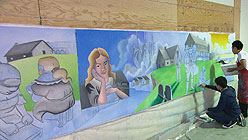The short story collection The Pastures of Heaven isn’t the first title that springs to mind when you talk about author John Steinbeck, but his sharp-eyed portraits of human nature and life in a Salinas Valley farming community in the 1920s have inspired a new play by San Francisco-based playwright Octavio Solis.
Commissioned by the California Shakespeare Theater as part of their New Works, New Communities series, John Steinbeck’s The Pastures of Heaven takes viewers on a journey into the heart of the American Dream as seen through the eyes of the Munroe family and the other ordinary folks of Las Pasturas del Cielo, a small village situated along the stretch of Highway 68 between Monterey and Salinas. Spark follows Solis as he explores Salinas and the stunning valley of Corral de Tierra, the real-life setting for The Pastures of Heaven, in order to draw inspiration for his adaptation.
Solis, a native of El Paso, Texas, has seen his poetic dramas produced at festivals and venues all over the country, from the Oregon Shakespeare Festival to the Magic Theater in San Francisco, from the New York Summer Play Festival to the Yale Repertory Theatre. He is the literary heir of a generation of Chicano playwrights, and his works, such as El Paso Blue and Lydia, trace a Latino experience that might not be prominent in The Pastures of Heaven. But in Steinbeck’s brief vignettes, Solis finds a dark undercurrent of human foibles and struggles that transcends culture.
The verdant pastures of green that inspired Steinbeck’s short story cycle were discovered accidentally in 1776 by a Spanish corporal, whose name has been lost to history. Throughout the 19th and early 20th centuries, ranchers and homesteaders established a loose community in the area, but from the late 1950s onward, development in the lush valley and the establishment of the posh Corral de Tierra Country Club gradually eroded the remnants of the farm community, as wealthy Silicon Valley businessmen built multimillion-dollar estates on the subdivided plots of land where cattle once grazed.
Partnering with the Word for Word Performing Arts Company, Solis and his fellow collaborators began extensive research and workshops in October 2007, all leading to the play’s premiere at the Bruns Amphitheater in Orinda in June 2010. The community outreach aspect of the project took the cast and crew to Salinas to work in the fields and learn firsthand about the world Steinbeck portrays, one that, even in 1932, Steinbeck saw slowly vanishing, like the dreams of his characters.
“If I have any vision, I tell you this,” says one of Steinbeck’s characters, in the author’s uncannily accurate voice, “some day there’ll be big houses in that valley, stone houses and gardens, golf links, and big gates and iron work. Rich men will live there, men that are tired of working away in town, men that have made their pile and want a quiet place to settle down to rest and enjoy themselves.”
Resources
- Array
- Array
- Array
Related Episodes
The Steinbeck Project
The Octavio Solis segment was produced by Spark for This Week in Northern California.

